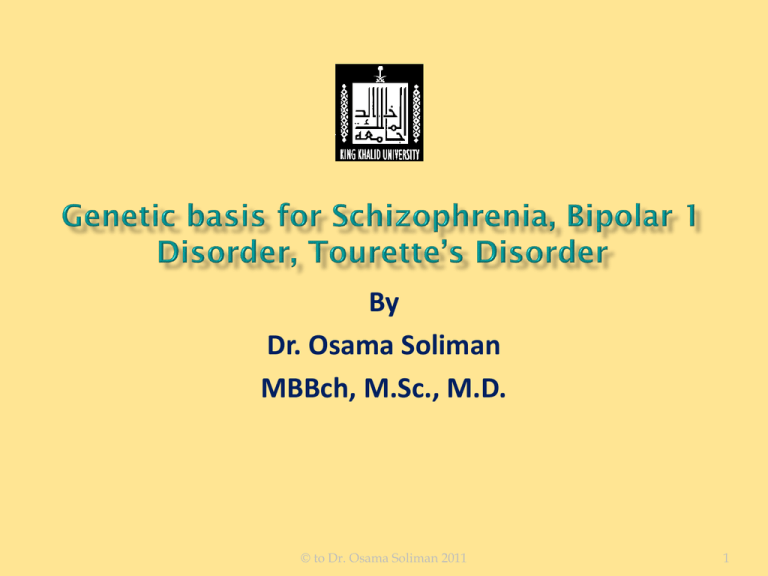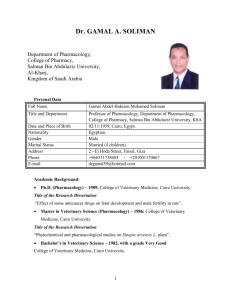Genetic basis for Schizophrenia, Bipolar 1 Disorder
advertisement

By Dr. Osama Soliman MBBch, M.Sc., M.D. © to Dr. Osama Soliman 2011 1 © to Dr. Osama Soliman 2011 2 We knew the genetic basis of schizophrenia through: 1) The risk for schizophrenia in GP is 1% only. 2) Genetic studies indicated that: a- a person is likely to have schiz. when other family members have the illness. b- the likelihood of a person having schiz, is correlated with the closeness of the relationship, e.g., 1st 2nd degree relative. © to Dr. Osama Soliman 2011 3 3) The risk for schizophrenia in a 1st degree relative is higher; Non twin sib of a patient 8% Child of one ill parent 12% Child of both ill parents 40% 4) The risk for schizophrenia in twins is much higher; DZ twin of a patient 12% MZ twin of a patient 47% © to Dr. Osama Soliman 2011 4 5) Adoption studies for MZ twins indicated that: a-twins reared by adoptive parents have schiz, at same rate as their twin sibs reared by their biological parents. b-this means the genetic influence outweighs the environmental influence. c-also, the more severe the schiz. Is, the more likely the twins become concordant for the disorder. © to Dr. Osama Soliman 2011 5 Chromosomes implicated are Most common are: Long arms of chromosomes 5, 11, 18 & Short arms of chromosomes 19, X. Less common are: Loci on chromosomes 6, 8, 22. © to Dr. Osama Soliman 2011 6 Why chromosome 11-long arm is important: 1- because schiz, can result from dopamine dys-regulation. 2- dopamine synthesis start by conversion of tyrosine to DOPA. 3- this conversion is catalyzed by tyrosine hydroxylase. 4- this enzyme is vital (rate-limiting enzyme). 5- this enzyme is controlled by a specific gene. 6- this gene is located on the long arm of chromosome 11. 7- this is why tyrosine dietary variations does not affect dopamine. © to Dr. Osama Soliman 2011 7 What is the gene for schizophrenia - Human behavior & traits are complex - They are controlled by multiple genes not a single gene. - e.g., are intelligence, personality, eye’s color, skin color. - So brain itself is controlled by many genes. - Some genes control brain development. - Others control brain functions. - Others control brain maintenance. - This is why many genes are implicated in schiz, etiology. © to Dr. Osama Soliman 2011 8 Other genes for schizophrenia: - Patients have difficulty filtering auditory input to screen out Extraneous sounds. - Positional cloning detected locus on ch. 15 encoding α1-nicotinic acetylcholine receptor that accounts for the above abnormality in several pedigrees of schiz, patients. - This is why schiz, patients smoke to ↓ hallucinations. © to Dr. Osama Soliman 2011 9 Other genes for schizophrenia: -There is a –ve association between schiz, and rheumatoid arthritis(RA). - The HLA (human lymphocyte antigen)DRBI*04 allele is associated with marked reduction in risk for RA in schiz, pts. - The genes affected in schiz, does not give the disease but the vulnerability. © to Dr. Osama Soliman 2011 10 © to Dr. Osama Soliman 2011 11 - There is data indicating significant genetic factor in the development of mood disorders. - The genetic component plays more significant role in transmitting bipolar-I disorder (BID) than major depression. © to Dr. Osama Soliman 2011 12 Family studies 1- studies repeatedly found that: 1st degree relatives of BID probands (1st ill subject in a family) are: 8-18 times more likely than 1st degree relatives of controls To have BID; 2-10 times more likely to have major depression. © to Dr. Osama Soliman 2011 13 Family studies 2- studies also found that: 1st degree relatives of major depressive disorder probands are; 1.5-2.5 times more likely to have BID than 1st degree relatives of normal control subjects; 2-3 times more likely to have MDD © to Dr. Osama Soliman 2011 14 Family studies 3- the likelihood of having mood disorder ↓as the relationship widens: e.g., 2nd degree relative (cousin) is less likely be affected than a 1st degree relative (brother). 4- inheritability of mood disorders: 50% of all BID have at least one parent with a mood disorder (usually MDD). With 1 parent having BID, there is a chance of 25% having an ill child. With both parents ill, the chance ↑to 50-75%. © to Dr. Osama Soliman 2011 15 Adoption studies Studies indicated that: 1- Biological children of ill parents remain at increased risk of Having mood disorders, even if reared by healthy adoptive Families. 2- the prevalence of mood disorders in the adoptive parents Is similar to baseline prevalence in GP. © to Dr. Osama Soliman 2011 16 Twin studies For BID: Concordance rate in MZ twins 33-90% Concordance rate in DZ twins 5-25% For MDD: Concordance rate in MZ twins 50% Concordance rate in DZ twins 10-25% © to Dr. Osama Soliman 2011 17 Linkage studies - Linkage study is the one trying to associate specific gene/gene Marker and certain disorder. - Associations between BID and genetic markers are found for chromosomes 5, 11, 18, X. - The D2 receptor gene is located on chromosome 5. - The tyrosine hydroxylase gene is located on chromosome 11. - In one study, markers on ch.18 were found in some families with bipolar disorder. © to Dr. Osama Soliman 2011 18 Linkage studies and psychiatry - Linkage has long been suggested between BID & region on chromosome X that contains genes for color blindness & Glucose-6-phosphate dehydrogenase deficiency, but… - Molecular genetics techniques led to contradictory results→ - Some studies find linkage, others do not. - This could mean, an X-linked gene is a factor in development of BID in some patients & families, but not in others. © to Dr. Osama Soliman 2011 19 Linkage studies and psychiatry - Same problem faced us with the association between BID & genetic markers on short arm of chromosome 11. - In 1987, an association was found as above in certain families. - but, once new family members became ill, the association ceased to exist. - What happened is that, the newly affected family members led to extension of the pedigree, leading to loss of the statistical association. © to Dr. Osama Soliman 2011 20 © to Dr. Osama Soliman 2011 21 Twin studies Concordance rate is much higher in MZ twins than in DZ twins. Family studies -Tourette’s and chronic motor or vocal tic disorder are likely to occur in the same family, supporting the view that the disorders are part of a genetically determined spectrum. - Mothers with Tourette's have sons with higher risk for same illness. - The mode of transmission of Tourette's in some families is autosomal. © to Dr. Osama Soliman 2011 22 Family studies - Recent studies, suggested a bilinear mode of transmission; - Meaning, the disorder is inherited through autosomal pattern intermediate between dominant and recessive. - Genetic factors are present in about 75% of cases, with 25% presenting with bilinear transmission (both parents affected). - You can say that Inheritance: Autosomal dominant, with reduced penetrance. © to Dr. Osama Soliman 2011 23 Comings, D. E. Blood serotonin and tryptophan in Tourette syndrome. Am. J. Med. Genet. 36: 418-430, 1990. [PubMed:2389798] 1-found significant decreases in the serotonin/platelet ratio and in blood tryptophan level in unmedicated patients with GTS. A comparable significant decrease was found in parents of GTS patients, and there was no difference between parents with and those without symptoms. From these findings, Comings (1990) suggested tryptophan oxygenase (TDO2; 191070) as a possible candidate gene. 2-The SLITRK1 gene on chromosome 13 is the first gene known to be associated with Tourette syndrome. © to Dr. Osama Soliman 2011 24 3-In a new study, a family in which the father and all eight offspring (six sons and two daughters) have the syndrome. Extensive genetic detective work led them to a mutation in a gene called HDC, which encodes L-histidine decarboxylase, an enzyme involved in the production of histamine, a signaling molecule with a wide variety of roles throughout the body. The same mutation was present in all members of the family who had Tourette but was absent in thousands of DNA samples from control subjects, who included unrelated people with similar ethnic backgrounds as well as a group of 720 Tourette patients, The mutated version of the HDC gene likely results in a truncated version of the enzyme, which would result in reduced histamine levels, © to Dr. Osama Soliman 2011 25 - Currently, pedigrees are assembled for every main mental disorder and chromosomal linkage has been sought with the Tools of molecular genetics. But, - Even with a given straightforward mental disorder (Tourette) screening of almost all chromosomes has failed to identify specific genetic locus always inherited with the clinical behavior. - This means, each mental disorder is a “multigenetic trait”, i.e., under the combined influence of several genes. © to Dr. Osama Soliman 2011 26









